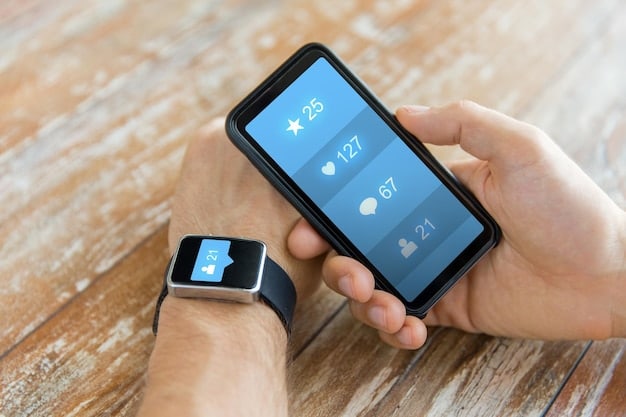Smartwatch Stress: 3 Ways to Reclaim Your Calm with Data

Feeling overwhelmed by your smartwatch? Discover three data-backed strategies to manage stress and anxiety, allowing you to harness the benefits of mindful technology while minimizing its potential negative impacts on your mental well-being and daily life.
Is your smartwatch, designed to enhance your life, actually contributing to your stress levels? It’s a common concern. Let’s explore how to recognize and address the issue, using actionable strategies to reclaim your calm with data-driven solutions.
Understanding Smartwatch Stress and Its Impact
Smartwatches, with their constant stream of notifications and health data, can inadvertently increase stress. Understanding how these devices impact our psychological well-being is crucial for mitigating potential negative effects.
The Paradox of Connectedness
While smartwatches promise enhanced connectivity and efficiency, they can also foster a sense of being “always on,” leading to information overload and heightened anxiety.
The Pressure of Performance Tracking
The constant monitoring of fitness metrics, sleep patterns, and heart rate variability can create self-imposed pressure to optimize performance, potentially triggering stress and self-criticism.
- Increased anxiety due to constant notifications and alerts.
- Disrupted sleep patterns resulting from blue light exposure and obsessive monitoring.
- Heightened self-criticism related to fitness tracking and performance goals.
- Feelings of inadequacy due to social comparison with other smartwatch users.
By acknowledging the potential downsides of smartwatch usage, we can take proactive steps to mitigate stress and cultivate a healthier relationship with technology. It’s about finding a balance between leveraging the benefits of these devices and safeguarding our mental well-being.
Data-Backed Strategy 1: Optimize Your Notification Settings
One of the most effective ways to reduce smartwatch-related stress is to carefully manage your notification settings. By customizing which alerts you receive and when, you can minimize distractions and regain control over your attention.
Prioritize Essential Notifications
Identify the notifications that are truly important and disable the rest. Focus on alerts from key contacts, critical appointments, or essential apps.
Implement “Do Not Disturb” Periods
Schedule specific times each day, such as during work hours, meals, or before bed, when notifications are silenced. This allows you to focus on the present moment without constant interruptions.

- Turn off non-essential app notifications (e.g., social media, games).
- Customize notification sounds and vibrations to differentiate between important and less urgent alerts.
- Use focus modes or quiet hours to automatically silence notifications during specific activities.
- Review and adjust notification settings regularly to ensure they align with your evolving needs.
Strategic notification management empowers you to reclaim your focus, reduce anxiety triggers, and create a more peaceful relationship with your smartwatch. It’s a simple yet powerful step towards a more mindful tech experience.
Data-Backed Strategy 2: Mindful Data Consumption
The sheer volume of health data generated by smartwatches can be overwhelming. Learning to consume this information mindfully, rather than obsessively, is essential for stress reduction.
Set Realistic Tracking Goals
Avoid the temptation to track every metric imaginable. Instead, focus on a few key areas that align with your specific health and fitness goals.
Establish Data Review Boundaries
Designate specific times for reviewing your smartwatch data. Resist the urge to constantly check your stats throughout the day, which can fuel anxiety and self-criticism.
Focus on Trends, Not Individual Data Points
When analyzing your data, look for overall trends and patterns rather than fixating on daily fluctuations. This helps you gain a broader perspective and avoids unnecessary worry.
- Use data to inform your choices, not dictate them.
- Recognize that data is simply information, not a reflection of your worth.
- Practice self-compassion when interpreting your data, avoiding harsh judgments.
- Focus on progress, not perfection, acknowledging that setbacks are a natural part of the journey.
Mindful data consumption transforms your smartwatch from a source of stress into a valuable tool for self-awareness and positive change. It’s about using data to empower yourself, not to fuel anxiety.
Data-Backed Strategy 3: Use Your Smartwatch for Stress Reduction
While smartwatches can contribute to stress, they can also be used as tools for stress reduction. Many devices offer features designed to promote relaxation and mindfulness.
Explore Guided Breathing Exercises
Many smartwatches offer built-in guided breathing exercises that can help calm the nervous system and reduce feelings of anxiety.
Utilize Mindfulness Apps
Integrate mindfulness apps with your smartwatch to access guided meditations, soothing sounds, and other relaxation techniques.

- Practice mindful movement activities like yoga or tai chi, using your smartwatch to track your progress.
- Use your smartwatch to set reminders for breaks throughout the day, encouraging you to step away from your work and engage in relaxing activities.
- Monitor your heart rate variability (HRV) to gain insights into your stress levels and track the effectiveness of your stress-reduction techniques.
- Use your smartwatch to create a personalized stress-reduction toolkit tailored to your specific needs and preferences.
By harnessing the power of your smartwatch for stress reduction, you can transform it from a potential source of anxiety into a valuable ally in promoting mental well-being. It’s about intentionally using technology to cultivate calm and resilience.
Leveraging Technology for a Balanced Lifestyle
Finding a healthy equilibrium between technology and mental well-being requires a proactive and mindful approach. It’s about consciously shaping our interactions with devices like smartwatches to enhance our lives without sacrificing our peace of mind.
Setting Boundaries with Technology
Establishing clear boundaries for technology use is critical not only for stress management, but also relationships. It’s difficult to be present with loved ones when attention is divided.
Prioritizing Real-World Interactions
While technology provides countless opportunities for digital connection, it’s important to prioritize meaningful real-world interactions. Taking time to disconnect from devices and engage in activities can significantly reduce stress.
Ultimately, creating a balanced lifestyle involves consciously curating our digital experiences to align with our values and promote self well-being. It’s about intentionally choosing how we use technology, rather than allowing it to control us.
Long-Term Strategies for Mindful Tech Use
Adopting a long-term approach to mindful technology use involves integrating strategies into our ongoing routines. Small, regular changes to our habits will increase our awareness, and minimize stress.
Regularly Evaluate Tech Habits
Take time to review your tech habits and identify areas where you can reduce stress. Small changes to your daily technology use can have a significant impact.
Cultivate Digital Minimalism
Digital minimalism is the process to minimize time distractions from tech. Reducing the amount of daily consumption, and apps can help maintain well being.
- Set a Digital Sabbath.
- Turn Off Notifications.
- Declutter Digital Spaces.
Ultimately, creating a balanced lifestyle involves consciously curating our digital experiences to align with our values and promote well-being. Adjustments to lifestyle choices can promote self care.
| Key Point | Brief Description |
|---|---|
| 🔔 Optimize Notifications | Filter alerts to reduce interruptions & anxiety. Receive notifications only by contacts that are crucial. |
| 📊 Mindful Data | Set tracking goals and data review boundaries. |
| 🧘 Stress Reduction Apps | Use breathing exercises and for mindfulness. |
| ⏱ Tech Balance | Prioritize real-world and set boundaries. |
Frequently Asked Questions (FAQ)
▼
Yes, constant notifications and the pressure to track health metrics can lead to increased stress. However, by making adjustments to how a smartwatch is used, negative impacts can be minimized.
▼
If you feel anxious or overwhelmed when using your smartwatch, constantly check notifications, or experience sleep disturbances, it may be contributing to your stress. Adjust usage to manage stress.
▼
Traditional methods such as exercise, meditation, and hobbies can be effective. You can also consult a healthcare professional for personalized advice to manage stress.
▼
Yes, you can use your smartwatch to reduce stress with features like guided breathing exercises and mindfulness apps like guided mediations, ultimately using technology as a tool for wellness.
▼
You should evaluate your smartwatch usage every couple of weeks to readjust settings and habits as needed. Make it a habit to promote mindfulness with technology, and manage stress .
Conclusion
By implementing data-backed strategies such as optimizing notifications, practicing mindful data consumption, and leveraging your smartwatch for stress reduction, you can reclaim your calm and cultivate a healthier relationship with technology. Remember, it’s about finding a balance that empowers you to thrive in the digital age.





